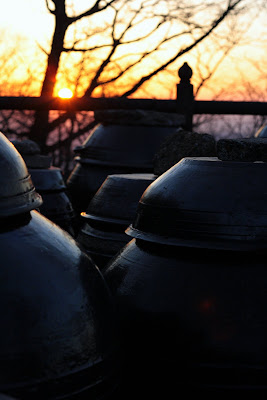Sunday, May 02, 2010
Discovering the Korean Spirit: Jiri Mountain
They say that the spirit of the Korean people flows from here at Changwongbong, the summit of Jirisan, the highest mountain on the South Korean peninsula. It was easy to see why. Even in the haze of the mid-afternoon sun, we could see for miles, the mountains stretching beyond in fading shades of blue until they disappeared. From where I stood, 1915 meters above sea level, I was not only privy to one of the most spectacular views in the country, I was also the tallest person this side of the DMZ.
It was an arduous journey to the top, made harder still by the bottle of soju and six rolls of kimbap weighing my pack down (three each chicken and tuna), but for once in my short mountain-climbing career, I didn't feel completely out of my league. Looking back, I suppose the fact that my chest was heaving like a toy boat in a tempest and my legs were cramping from the strain of the first hour of hiking should have told me that I was in fact, out of my league. But the the ajummas I passed on my way up the 60-degree trail looked like they were having a harder time of it than I (nevermind that they were 40 years my senior), and so my confidence was buoyed. Usually, they're passing me as I huff and puff up an endless flight of stairs. Score one for youthful exuberance.
We camped at the Rotary Shelter, described in promotional materials as little more than a hut with no toilets or running water, perched precariously on the side of a mountain. In reality, it was a log cabin with stinky toilets perched precariously below Bopgyesa, one of the highest temples in Korea. The only water source at the shelter was a spring bubbling from a rock a mere 30-meters uphill, at the entrance to the temple, making a midnight drink impractical, but for those with enough foresight to fill up their bottles before embarking on the two kilometer journey to the summit, it was a heavenly gift.
Rules at the shelter were rigidly enforced: lights out at 8pm, no eating or drinking inside the bunks, and boys and girls sleep separately. At first the early bedtime sounded ridiculous (were we at summer camp again?), but the effort of hauling myself 1600 meters up the side of a mountain made me too tired to complain and most of us were fast asleep on the hard wooden floors of the shelter when the lights went out.
Early to bed, early to rise, and the next morning we awoke to watch the sun rise from a specially-built balcony at Bopgyesa. I had to forgo my usual morning coffee due to a lack of hot water (powdered latte doesn't dissolve as well in cold water), but the rich reds of the temple against the pale blue mountains was enough stimulation to wake me.
An early-morning hike to the summit found me for the second time in as many days scrambling up a trail more suited to goats than reckless twenty-somethings. Someone recounted a legend about a group of North Korean soldiers hiding on the mountain after the Korean War. It took the southern government something like four years to find the communists in the rugged terrain. I believed it.
Just before the summit, the trail devolved into something resembling a rockslide more than the well-traveled path that it was. We scrambled up the rocks with the help of one heavy-duty rope, dragged ourselves up one final flight of stairs, hauled our aching bodies to the top of a small rocky outcropping, and gazed down at the morning mist hanging in the pale blue valleys below. We followed the lead of those around us and kissed the stone marking the top, the Korean spirit filling our tired bones.
-----
If you haven't seen my pictures from this weekend, go look at them now!
Subscribe to:
Post Comments (Atom)






No comments:
Post a Comment